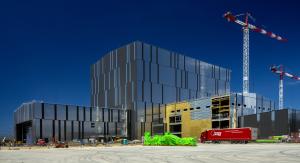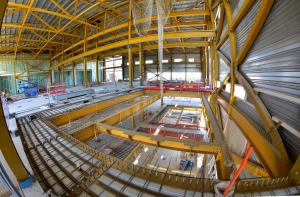The wave factory
17 Jul 2017
A year ago, work was just beginning on the steel reinforcement for the building's foundation slab. The Radio Frequency Heating Building is now nearing the last stages of completion. The space inside the 26-metre-tall building will be shared by two radio-wave-generating systems designed to feed energy, in the form of electromagnetic radiation, into the plasma.
Originally planned for installation inside the Assembly Hall, equipment for the electron and ion cyclotron external heating systems (power supplies and generators) now has a three-storey building of its own. Located adjacent to the emblematic 60-metre-tall Assembly Hall, the structure is in the last stages of completion, as insulation and cladding is installed on the facades and finishing works are underway inside. As a red delivery truck passes in front of the building, the elements for the first large sector sub-assembly tool wait under their green wrapping for installation in the Assembly Building.
Power supplies for both resonance heating systems (a total input of 100 MW) will occupy the better part of the first two floors, while the top floor will be reserved for the wave generators—gyrotrons for electron cyclotron resonance heating (ECRH) and ion for the ion cyclotron resonance heating (ICRH). The construction of the Radio Frequency Building is nearing completion, with small regions of the second and third floor to be poured and removable internal hatches to be installed. The final task for the structural part of the building will consist in inserting two overhead cranes.



